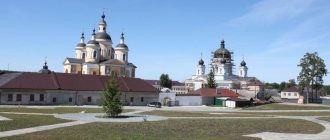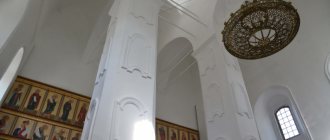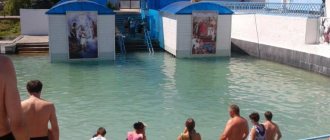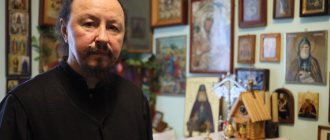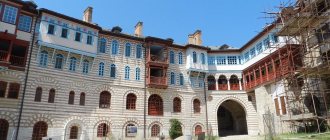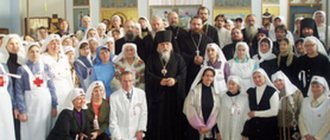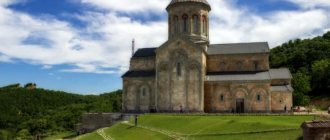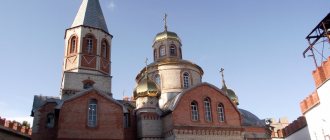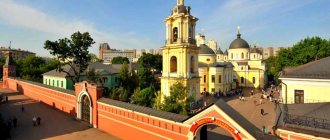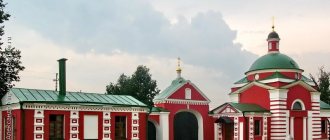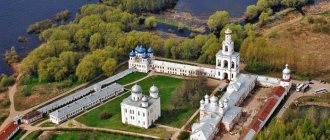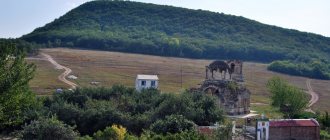The Vyshensky Assumption Convent, whose website can be visited at any time (listed below, in the “Contacts” section), is known not only to local residents.
He has his own story, full of joyful and sad moments. But you need to know about all such events, since it is from the little things that a complete historical picture of the spiritual and cultural heritage of the Russian state is formed.
People come here from different parts of their native country and even from near and far abroad. It attracts pilgrims with its special atmosphere of calm, tranquility and sublimity above worldly problems.
Description and location
Located in Vyshe, Shatsky district. Is a women's monastery. The relics of St. Theophan the Recluse are located here. It is thanks to this fact that the monastery gained fame and popularity. It was built quite a long time ago and was originally for men.
The Ryazan region can be proud that such a significant creation of human hands is located on its territory. The immediate location from populated areas is the village of Vysha near the city of Shatsk (about 25 kilometers from it). The place is quite picturesque at any time of the year, especially in summer.
Please note: the village itself is conveniently located where the Vysha (its tributary) flows into the Tsna River.
Story
History comes from various sources. Some of them are tales, traditions and legends. And there are documented facts.
The initial existence of the Vyshenskaya Assumption Hermitage is known partly from legend, partly from documents given in the book of Abbot Tikhon (Tsiplyakovsky), published in Tambov in 1881.
Its foundation dates back to the 16th-17th centuries. However, it is reliably known that already in the first quarter of the 17th century, this structure existed.
It is worth noting: initially the Vyshinsky Monastery, according to some sources, was located several kilometers from its new location.
In the 18th century the shrine was subjected to destruction and robbery, but its inhabitants survived. The monastery flourished in the 19th century, when it came into the possession of the Tambov diocese. The twentieth century was marked for the monastery by both ruin and a new revival.
If suddenly you didn’t already know, then we advise you to read the article about what is remarkable about the Church of the Resurrection of the Word on Arbat.
Testimony of Hieromonk Leonty
Only towards the end of the century did life in the monastery gradually improve, as evidenced by the inventory of property compiled in 1798 by Hieromonk Leonty. In it, in addition to a detailed list of everything that the brethren owned, there is a record that the monastery, which was previously assigned, finally received independence, although it remained unemployed, that is, not receiving material support from the state.
Nevertheless, the author of the document indicates that it had a stone Assumption Church, next to which stood a bell tower covered with planks, and the entire territory was fenced with a strong wooden fence. The brethren's farm remained small: it consisted of hay cutting and a bee yard. Hieromonk Leonty also provides a detailed list of all the monks, indicating the time of their entry into the monastery.
Fate during the revolution and Soviet times
Like many religious sites in our country, the monastery complex at the beginning of the 20th century.
closed. Everything that belonged to the monks became state property.
This phenomenon is not uncommon at that time.
Interesting fact: The Nativity Cathedral became the only place for a short period of time where services were held. However, this only lasted until 1938.
In the 70s 20th century a couple of clergymen dared to break into an abandoned building. They saw the complete barbaric destruction of the complex. They also found the remains of Bishop Theophan and performed a memorial service. In this secret way, the clergy slowly restored order here and took significant relics to a safe place.
Current state
The year 1988 became significant for the entire Orthodox world. This year the saint was canonized, that is, he was canonized. This fact became the starting point for the revival of the monastery. It was also helpful to involve the public in this event.
Time was not long in coming. Already in 1990, active restoration of the site began. He was handed over to the caring hands of believers. And in 2002, the Vyshensky Assumption Convent appeared to the world.
It is important to know: the consecration was carried out by Patriarch Alexy II, who was the Patriarch of Moscow and All Russia. He also blessed the transfer of the relics of St. Recluse.
Time for good changes
The next 19th century was the most fertile period in the life of the Vyshensky Assumption Monastery, which reached its greatest prosperity in the second half. This was largely facilitated by the transfer of the monastery to the jurisdiction of the Tambov diocese, then led by an outstanding religious figure of his era - Archbishop Theophilus (Raev). Thanks to his care, the brethren were able to rebuild dilapidated and unusable premises, as well as carry out major repairs where possible.
The Vyshensky monks were not left without a wise shepherd, who, by order of Archbishop Theophilos, became Hieromonk Tikhon, who was transferred to them from the Sarov monastery. Having received the rector's baton, he carried out pastoral labors for 44 years, directing the brethren on the path of spiritual improvement and asceticism, which included the strictest self-restraints aimed at freeing the mind from the bonds of the vain world.
Description of the monastery architectural ensemble
The architectural ensemble includes several buildings. Among them you can find the Assumption Church, the Kazan Church, the bell tower and other buildings.
It is worth noting: the monastery ensemble appeared in this composition in the 19th century.
Today the monastery is a unique object that many pilgrims strive to see, touch the history of the Orthodox world, plunge into the unique atmosphere of this place, and venerate the holy relics of Father Theophan.
Nativity of Christ Cathedral
At the end of the 19th century, as part of the present architectural ensemble of the complex, a cathedral was built, which is now called the Nativity of Christ.
Did you know that: from the very beginning, the building was conceived as a “warm” church, where it would be possible and convenient to hold services during the cold season. Especially in winter, in severe frosts.
The structure has 2 thrones and 5 domes.
The Nine Martyrs of Cyzicus is the name of the revered icon located in the cathedral.
Kazan Cathedral
Construction took more than 10 years and ended only in 1844. The Sarov Assumption Cathedral served as the basis for the Kazan Cathedral, which is located in the Ryazan region. However, the decoration and its dimensions still could not reach the level of its prototype.
The building has 3 thrones and is five-domed in structure. The temple itself is very beautiful. Its columns and pediments are distinguished by their particular sophistication and sophistication.
Good to know: Bishop, theologian and publicist Theophan is the author of many icons that adorn the cathedral iconostasis. And the minister himself was buried near the walls of the Kazan Cathedral.
Assumption Church
It can rightfully be called the very first building that appeared as part of the architectural complex of the Vyshensky Monastery.
Its origin dates back to the 17th century. However, the history of the church is not so prosperous and wonderful.
At the moment, it is not located where it stood previously, since the first wooden building was moved. Now the church is made of stone, rebuilt on the site of the one that burned down.
It was illuminated in 1988 after a long restoration. By the way, it was decided to be one of the first to put this building in order.
Bishop's House Church
The complex includes many different buildings.
Some of them appeared in the 17th century. And others were rebuilt several centuries later.
Each of them is unique, has its own history and architectural features. So, the ensemble also includes the house church. She is inextricably linked with the name of the bishop.
Since this holy man was a recluse, he performed all his liturgies here.
Please note: official permission was received to organize a house church. The diocesan authorities blessed its arrangement. The event took place in 1867.
Bell tower
At the moment, the bell tower is a dismantled building. This happened back in the 70s. 20th century This happened to many Orthodox buildings. Neither small churches and chapels, nor large cathedrals and temples were spared. Even the fact that the objects have special cultural and historical value was not taken into account.
Please note: the bell tower was built in the first half of the 19th century. It previously had 14 bells already at the beginning of the 20th century. The heaviest bell was the one whose mass was 726 pounds.
Other buildings
There were also other buildings and structures on the territory.
So, in order to conduct competent economic and other life activities, 12 stone buildings were used for the brethren.
There was still 1 wooden building. It was used as a barn.
The outer area was also rich in guest houses. There were two of them. The complex received such arrangement at the beginning of the new 20th century.
Comments
irinag
26.04.16 21:42
The temples are magnificent, very beautiful! How lucky you were with your excursion! It is a great happiness for you to visit holy places! This is the first time I’ve seen an orange temple!))
- answer
annas
26.04.16 22:18
I was very lucky with the excursion, I agree, especially since it was free, but naturally little was left for the restoration of the monastery. And the Epiphany Church struck me on my first trip to Diveevo: a field, and suddenly such a large temple. It turns out that there used to be a rich trading village around it, so the merchants built such a majestic temple. Then it stood, collapsed, and only now they began to restore it, let’s hope they will finish the job.
- answer
galina
27.04.16 10:20
And I agree - I was lucky with the excursion. They don't do this everywhere. Not everywhere, even where they are held, you will get there. I have been, but rarely... Anyut, you have made a wonderful start to your trip to the Holy Places. I really liked the photos. The colors are truly special...
- answer
annas
27.04.16 16:09
Galya, to be honest, I was upset at first because of the construction, but the excursion saved everything, and we went on with a great mood. And the weather was interesting - from clear, sunny skies to gray gloomy clouds, and all this happened very quickly.
- answer
olgap
01.05.16 09:57
How many beautiful places we have in Rus'. Drive not move!
- answer
annas
01.05.16 10:39
That's for sure! You start “digging” before traveling, and you realize that there is not enough time for everything, no matter how hard you try.
- answer
annas
14.05.16 17:32
By the way, Vysha entered the top ten most visited shrines in Russia by tourists and pilgrims, I’m surprised. In first place, of course, is Diveevo. https://www.kp.ru/daily/26524.7/3540572/
- answer
karina
22.05.16 01:47
I would like to follow your route, Anechka, and attend excursions. But probably in two years, so that I can see the restored architecture for both my soul and my eyes. It is always more interesting, of course, to visit a place of considerable age than a new one. Although carefully restored buildings deserve great respect.
- answer
annas
22.05.16 16:22
There are a lot of interesting things in the Ryazan region, some are just better preserved, but somewhere else it becomes sad. We went to Yorlino, to the arboretum and Khudekov’s estate (his arboretum is still in Sochi), and returned with sadness, just like from Zaborovo, from Skobelev. And it’s spinning in my head: Two estates - two destinies. Beautiful estates, great names, but everything was destroyed, and they are trying to restore it, but they are just trying, it’s sad...
- answer
AllaB
22.05.16 13:17
#10
Anna, a wonderful story about a wonderful place. I really love churches where they don’t teach, but just let you enjoy the views, the surroundings, the story! And a temple in an open field is something! Welcome back!!! (otherwise someone frightened us with a long absence)
- answer
annas
22.05.16 16:14
#11
And it continues to some extent. Peter lies, there are three materials on the Ryazan region, but not written. Only now I’ve become more calm about it: it doesn’t say that, it doesn’t say that, whatever you do.
- answer
Saints of the Vyshensky Monastery
Theophan, glorified among the saints, lived in the 19th century. He is still the most famous theologian and preacher in Orthodox circles. Another of his activities is called journalistic activity.
Feofan the Recluse (in the world Georgy Vasilyevich Govorov; January 10 (23), 1815 - January 6 (18), 1894) - bishop of the Orthodox Russian Church; theologian, publicist-preacher
Life of St. Feofana is quite interesting. He had a spiritual education and a clear intention to serve the church throughout his life. After graduating from the seminary and theological academy, the young man became a monk.
Important to know: St. Feofan helped improve the level of education by creating Sunday schools, parish and other educational institutions, for example, a diocesan school for the female population.
Arriving in the Vyshenskaya Hermitage, he remained here until the end of his days. His burial took place in the Kazan Cathedral.
In the 1920s, the monastery was closed and the monks were evicted from the monastery.
In the 1920s, the monastery was closed, the property of the entire monastery was nationalized, and the monks were evicted.
1938
starting this year, a regional psychiatric hospital was located in the monastery buildings
The territory of the monastery later began to be used as forestry, as well as a state farm for pig breeding. And since 1938, a regional psychiatric hospital was established in the buildings of the monastery.
In the 1960s, the bell tower was blown up.
One summer in 1972, Priest Georgy Glazunov and Abbot Mark, together with two other students of the theological academy, entered the then closed monastery, where the revered bishop St. Theophan was buried.
They saw in what terrible desolation the monastery itself and the relics of the saint were located. Together they all slowly took the relics with them.
A new revival of the monastery began in 1990, when part of the building was transferred to the church to organize a convent there.
On June 29, 2002, with the support and participation of Patriarch Alexei II, a solemn event was held to bring the relics of St. Theophan the Recluse to the Vyshenskaya monastery.
Shrines of the Vyshenskaya Monastery
Among the shrines of the Vyshenskaya Hermitage, the relics of St. Theophan stand apart. They were canonized in 1988.
Before being moved to their permanent location, they were located not far from the monastery, which was completely closed at that time.
A reliquary with shrines is also kept here. In this way, people are given the opportunity to venerate the holy relics and ask for help in one place, if it is not possible to arrive at the site of the saints’ deeds.
The Vyshenskaya Icon of the Mother of God of Kazan can also be found here. Many pilgrims come to pray, ask for help and intercession from the Mother of God. No one is left unanswered.
Take note: the relics of other saints are kept in small caskets in the monastery. For example, the remains of four Ryazan saints, as well as the venerable fathers of Kiev-Pechersk.
Information for pilgrims and tourists
Let's consider some points:
How to get there
Most often people arrive at this place via Moscow.
From the capital, you should find transport that can travel to Shatsk or in transit through it. At the bus station of this city there are always minibuses and minibuses that will take you to Vysha. It is there, at 20 Zarechnaya Street, that the famous monastery ensemble is located.
Where to stay
Before traveling to Vysha, you should take care of your stay there. For pilgrims and simply guests of the village, accommodation is provided a few kilometers from the shrines in the Bykovo courtyard. Multi-bed rooms for up to 10 people are available. At the same time, bedding is provided.
It is worth considering: you can also have lunch and dinner here. The cost of the stay is based on donations from pilgrims.
Contacts
To obtain information of interest, you can find out the detailed history of the complex and the biography of the saint on the official website: https://svtheofan.ru/. There you can also find links to pages on social networks.
If necessary, you can call: +7 (49147) 2-73-73.
Schedule of services and patronal holidays
On the official website you can find a schedule of services, which is presented for a certain period.
In the morning the service begins at 7 am. The evening party can be attended at 18:00.
The convenient table always contains information about the essence and focus of the service.
There are several patronal holidays. One of them is the Dormition of the Blessed Virgin Mary. Also, the day of the Kazan Icon of the Mother of God and, of course, the holiday in honor of St. Recluse.
A visit to this monastery in the Ryazan region is recommended for all Orthodox believers. This is one of those places that has a rich history, strewn with numerous interesting facts.
The presence of numerous shrines attracts many pilgrims to Vysha. Accommodation and transfers are provided for them. Arriving here will not leave anyone indifferent. The monastery makes only a positive impression on visitors.
We bring to your attention a video with the biography of St. Theophan the Recluse:
“I locked myself so as not to be disturbed”
His request was granted and sent to Vysha as rector, but he refused the position. As he later refused the offer to head the Moscow department. “I would not exchange my position not only for the St. Petersburg metropolitanate, but also for the patriarchate, if it were restored to us and I was appointed to it... I can only exchange my position for the Kingdom of Heaven,” he wrote.
In the first six years in the monastery, he, along with other monks, went to all church services, performed liturgy on Sundays and holidays, and received many visitors who came to him for advice. But after Easter 1872 he stopped all this, secluded himself in a separate wing, where he served liturgy every day in the house church built there, received only the rector, confessor and cell attendant, and devoted all his time to scientific, literary and translation works and extensive correspondence.
And everything he wrote was devoted, in essence, to one topic - salvation in Christ. He treated his own exploits with irony. “They made a shutter out of my constipation. There is nothing reclusive here. I locked myself away so as not to be disturbed, but not in the form of the strictest asceticism, but in the form of unhindered bookishness,” he wrote. And he added: “You can wander around the world with your doors closed, or let the whole world into your room.”
But this, of course, is out of humility. Many years of spiritual labor were not in vain for him. It is no coincidence that he predicted the Russian revolution more than 50 years before 1917.
